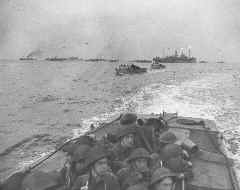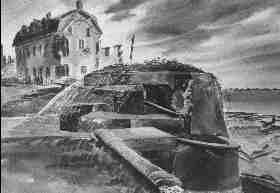Table of Contents | Assault from the Sky | Assault from the Sea | Advance Inland | Selected Awards | Reviews | Order of Battle
British Gallantry Awards | To Order
Outline of the Canadians on D-Day
Assault from the Sea
As soon as the decision for Operation OVERLORD had been taken, the 31st Canadian Minesweeping Flotilla was ordered to sea. Their task, along with nine other flotillas containing six additional Canadian minesweepers, was to remove the mines from the eight-mile deep German minefields leading to one of the American landing sectors, called Omaha Beach. It was slow and laborious work but at the same time, nerve-wracking, since they would be within range of the German coastal batteries. At 0515 on June 6, they completed their last of their work, surprisingly without any German reaction, and met the first of the assault ships steaming into the channels.
 The assaulting infantry were transported across the Channel in large Landing Ships Infantry (LSIs), on which the smaller assault craft (LCAs) were carried. When these ships reached their designated launching positions off the French coast, the LCAs were lowered into the sea and the infantrymen clambered on board. The LCAs headed in toward shore, with the plan to touch down five minutes after H-hour by which time, it was hoped, the advance engineers would have cleared a satisfactory number of beach obstacles.
The assaulting infantry were transported across the Channel in large Landing Ships Infantry (LSIs), on which the smaller assault craft (LCAs) were carried. When these ships reached their designated launching positions off the French coast, the LCAs were lowered into the sea and the infantrymen clambered on board. The LCAs headed in toward shore, with the plan to touch down five minutes after H-hour by which time, it was hoped, the advance engineers would have cleared a satisfactory number of beach obstacles.
Juno Beach was divided into two sectors, codenamed "Nan" and "Mike."
Nan Sector
The North Shore (New Brunswick) Regiment landed on the east side of Nan Sector. On leaving their landing craft, they were met with heavy enemy fire: the main enemy strong points had not been touched by the preliminary naval bombardment. As Lieutenant C.F. Richardson described it, "tracer bullets from German anti-aircraft guns seemed to fill the air as we came in&Once we were out of the boat, everyone acted mechanically heading for the beach and cover of the beach wall & we used our bangalore torpedoes with good effect and were at close quarters with the enemy after traversing through what we later discovered was a mine field."
 Sherman tanks of the Fort Garry Horse (Canadian 10th Armoured Regiment) finally reached the beach, and, as Lieutenant Richardson noted, this was "none too soon as we had lost seventeen men, dead and wounded, from the sniping and shelling." The tank squadron pushed forward and, at the cost of three tanks destroyed, destroyed the German strong point that was causing so much damage. Thirty enemy soldiers were killed and upwards of one hundred surrendered.
Sherman tanks of the Fort Garry Horse (Canadian 10th Armoured Regiment) finally reached the beach, and, as Lieutenant Richardson noted, this was "none too soon as we had lost seventeen men, dead and wounded, from the sniping and shelling." The tank squadron pushed forward and, at the cost of three tanks destroyed, destroyed the German strong point that was causing so much damage. Thirty enemy soldiers were killed and upwards of one hundred surrendered.
The Queen's Own Rifles of Canada landed on the centre beach of Nan Sector, with "A" Company on the right and "B" on the left. The rising tide left about two hundred yards of the beach exposed between the waterline and sea wall. This area was swept by German fire, causing severe casualties among the Canadians. The worst occurred to "B" Company which landed in front of a concrete strong point and almost half the company was lost in the initial dash across the beach. Despite this, the Canadians pushed ahead and overran the German defences.
On the west side of Nan Beach, two assault companies of The Regina Rifle Regiment landed on the edge of the Courseulles strong point. They also met strong resistance from concrete casemates that had not been satisfactory damaged by the preliminary bombardment. Despite heavy casualties, the survivors managed to reach the protection of large sand dunes, from where they fought along the promenade of the town, silencing all the enemy machine guns one by one.
Mike Sector
"B" and "D" Companies of The Royal Winnipeg Rifles landed on the other side of the Courseulles strong point, meeting heavy machine gun, shell and mortar fire when they were still 700 yards from the beach. Many men were hit in the water, as soon as the front ramp of the boat was lowered. They face what were perhaps the strongest beach defences, consisting of five large reinforced concrete blockhouses, along with numerous machine gun positions between these in concrete strong points amongst the sand dunes. As later reported by Peter Simonds, "despite the steel and concrete and mines, the Winnipegs broke into the beach defences in the most savage and furious fighting on the whole Normandy front on D-Day."
` On the far right of the Canadian landing area, one company of The 1st Battalion, Canadian Scottish Regiment had one of the easier touch-downs. The preliminary bombardment, for once, had done good work and the Canadians were able to get off the beach quickly. They encountered resistance inland, however, and had to fight their way through machine gun posts that had not been touched. Heavier fighting occurred against a strong point covering the village of Ste. Croix but this was overcome with the help of artillery and tanks from the 1st Hussars (Canadian 6th Armoured Regiment). By the end of the day they were six miles inland.
Table of Contents|Advance Inland
 The assaulting infantry were transported across the Channel in large Landing Ships Infantry (LSIs), on which the smaller assault craft (LCAs) were carried. When these ships reached their designated launching positions off the French coast, the LCAs were lowered into the sea and the infantrymen clambered on board. The LCAs headed in toward shore, with the plan to touch down five minutes after H-hour by which time, it was hoped, the advance engineers would have cleared a satisfactory number of beach obstacles.
The assaulting infantry were transported across the Channel in large Landing Ships Infantry (LSIs), on which the smaller assault craft (LCAs) were carried. When these ships reached their designated launching positions off the French coast, the LCAs were lowered into the sea and the infantrymen clambered on board. The LCAs headed in toward shore, with the plan to touch down five minutes after H-hour by which time, it was hoped, the advance engineers would have cleared a satisfactory number of beach obstacles.  Sherman tanks of the Fort Garry Horse (Canadian 10th Armoured Regiment) finally reached the beach, and, as Lieutenant Richardson noted, this was "none too soon as we had lost seventeen men, dead and wounded, from the sniping and shelling." The tank squadron pushed forward and, at the cost of three tanks destroyed, destroyed the German strong point that was causing so much damage. Thirty enemy soldiers were killed and upwards of one hundred surrendered.
Sherman tanks of the Fort Garry Horse (Canadian 10th Armoured Regiment) finally reached the beach, and, as Lieutenant Richardson noted, this was "none too soon as we had lost seventeen men, dead and wounded, from the sniping and shelling." The tank squadron pushed forward and, at the cost of three tanks destroyed, destroyed the German strong point that was causing so much damage. Thirty enemy soldiers were killed and upwards of one hundred surrendered.